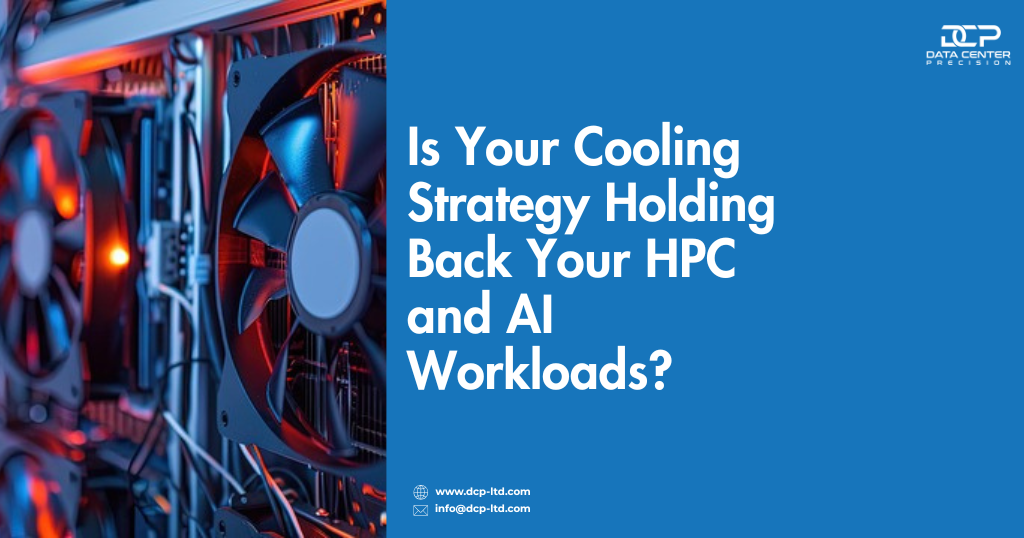Insights

Is Your Cooling Strategy Holding Back Your HPC and AI Workloads?
High-performance computing (HPC) and artificial intelligence (AI) are pushing data centers to their limits. The demand for dense processing power creates severe heat. If your cooling strategy hasn’t kept pace, it could be slowing down your systems and limiting future growth. This article explains the cooling needs of AI and HPC, explores available technologies, and shows how the right strategy supports better performance.
Does AI Need Cooling?
Yes. AI workloads often require powerful processors like GPUs and specialised hardware such as TPUs. These components run complex models, train on large datasets, and perform parallel computations, all of which generate substantial heat.
If your cooling system can’t keep hardware at safe temperatures, performance suffers. You may experience thermal throttling, system faults, or even hardware failure.
Whether you’re training a large language model or running real-time analytics, consistent cooling is non-negotiable.
What Is the Best Cooling for AI Workloads?
There is no one-size-fits-all answer, but many AI workloads now exceed the limits of traditional air cooling. The best approach depends on system density, power usage, and physical layout.
Running AI workloads with mixed results? We help clients review and redesign cooling strategies to match real hardware demands.
Common options include:
1. Rear Door Heat Exchangers (RDHx)
These are mounted on the back of server racks and absorb heat as it exits. They use chilled water to cool air directly at the source. RDHx can support higher rack densities than conventional systems.
2. Liquid Cooling
Liquid is far more effective than air at transferring heat. Options include cold plate cooling, where liquid flows through metal plates attached to processors, or immersion cooling, where hardware is partially or fully submerged in a thermally conductive fluid.
3. In-Row Cooling
These units are placed between racks and cool equipment at the row level. They respond quickly to changes in load and reduce the distance the air must travel.
4. Direct-to-Chip Cooling
This method uses liquid-cooled plates connected directly to high-power components. It is well-suited to AI systems using GPUs with high thermal output.
For most modern AI workloads, a move towards liquid-based cooling is often necessary. Air systems can still support lighter inference tasks, but if you’re running high-power training models, liquid solutions offer better control and thermal stability.
What Are the Cooling Technologies for HPC?
HPC environments often pack thousands of cores into small spaces. This density generates severe heat, and older cooling methods can struggle to cope.
Adding high-density hardware to your environment? We support phased upgrades that bring cooling, power, and performance into alignment.
Key cooling options for HPC include:
Liquid Cooling
This is now a standard in many HPC facilities. Cold plates and direct-to-chip loops help maintain consistent temperatures across dense nodes.
Immersion Cooling
Here, servers are placed in dielectric fluids. Heat transfers directly from the hardware to the fluid, then to a heat exchanger. This method supports very high densities and can reduce cooling energy use.
Rear Door Cooling
Still common in HPC settings, this helps manage airflow and targets rack-level hot zones. It’s often used with chilled water systems.
Hybrid Systems
Many facilities use a mix of air and liquid systems. For example, CPUs might be cooled with air, while GPUs use cold plates. This approach reduces retrofit costs in existing environments.
HPC workloads are sustained and heavy. A cooling system that works well under peak load and doesn’t rely on constant manual adjustment is essential.
Which AI Technique Is Often Used to Optimise Performance in HPC Systems?
AI itself is being used to improve HPC operations. One commonly used technique is machine learning–based workload scheduling. Machine learning models analyse usage patterns and predict resource demand. This helps allocate workloads more efficiently, reducing energy waste and preventing systems from overheating.
Other techniques include:
- Thermal modelling with neural networks to predict temperature changes and adjust cooling pre-emptively.
- Predictive maintenance models that track wear on fans, pumps, and chillers.
- Energy consumption analysis that identifies underused systems or inefficient cooling loops.
Using AI to monitor and adjust your HPC environment means less guesswork and fewer performance drops due to heat.
Why the Right Cooling Strategy Matters
As AI models grow and HPC clusters become more dense, the supporting infrastructure must adapt. Cooling isn’t just about hardware safety. It impacts power use, uptime, and long-term costs.
Some organisations find that their systems have the right computing power but run at reduced speeds because of thermal limits. Others over-provision cooling without targeted design, leading to waste and higher energy bills.
A well-planned strategy should:
- Match current workloads without blocking future growth
- Allow flexible expansion in high-density zones
- Reduce energy use while keeping systems safe
- Integrate with monitoring tools to make data-driven adjustments
Working with experienced engineers helps you choose the right mix of technologies for your workloads, space, and power profile.
Interested in working together?
At DCP Ltd, we work with data centre operators and end-users to design cooling strategies that support today’s AI and HPC requirements without overbuilding or compromising performance.
Whether you’re planning an upgrade, adding high-density racks, or designing a new facility, we’ll help you assess, plan, and implement a practical cooling solution tailored to your workloads.
Are you ready to build with confidence? Book a consultation today.

2 Comments
David Shon
Nam vel lacus eu nisl bibendum accumsan vitae vitae nibh. Nam nec eros id magna hendrerit sagittis. Nullam sed mi non odio feugiat volutpat sit amet nec elit.
Jhon Watchson
Nam vel lacus eu nisl bibendum accumsan vitae vitae nibh. Nam nec eros id magna hendrerit sagittis. Nullam sed mi non odio feugiat volutpat sit amet nec elit.